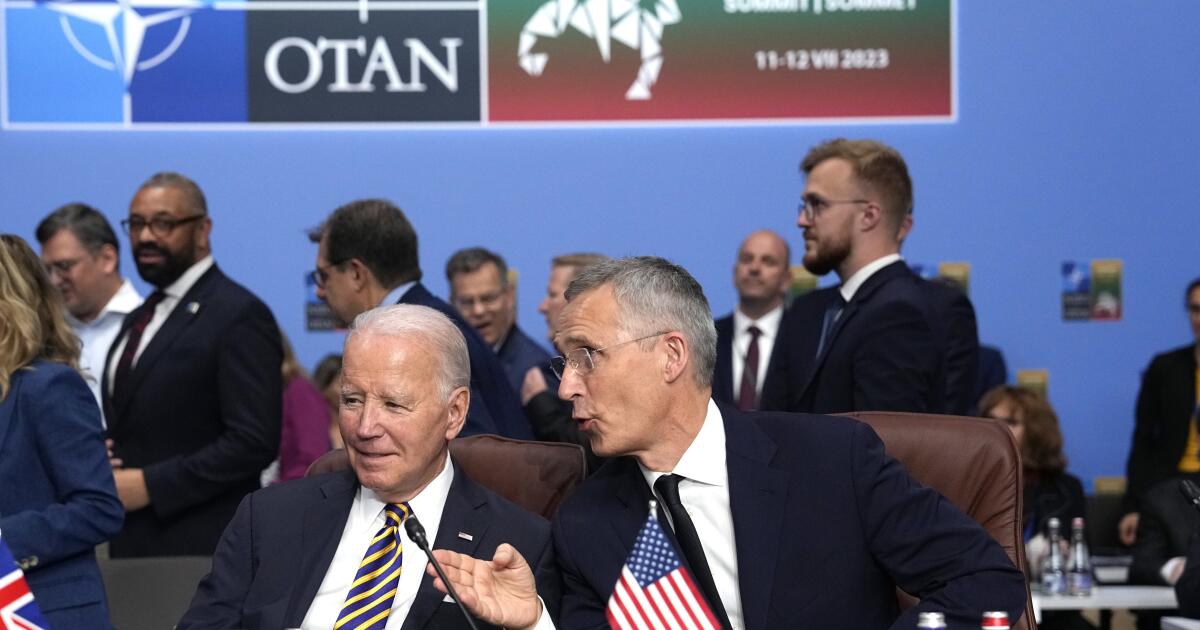However, despite expressions of goodwill and firmness, the gathering of the North Atlantic Treaty Group, which begins on Tuesday, comes as one of the 32-nation bloc’s most notable leaders has been left out and among some of the most politically wounded. Will be counted, and at a depressing level The conflict in Ukraine is now on its third wave.
It’s all become a level playing field as EU leaders begin to grapple with the prospect of another presidency for presumptive Republican nominee Donald Trump, who has suggested he will now withdraw from NATO’s fundamental mutual-defense promises, including Will not respect transatlantic treaty loyalty.
Trump announced in February that if the deadly disease of hostilities concerned individuals who “didn’t pay” — a perennially misleading characterization of the alliance’s price range — then he would inform Russia to “do whatever they want.”
The roster of member states’ leaders reflects a date of unease and turmoil on each side of the Atlantic.
President Biden, who is hosting the series, is facing calls to abandon his re-election bid due to a debate performance that left him looking weak and frail.
France was plunged into deep political uncertainty after the mixed result of its parliamentary election left President Emmanuel Macron’s centrists vulnerable – though early projections of Sunday’s vote suggest French voters nationwide want a bid for power from the far right. . Rally.
Untested British top minister Keir Starmer is reeling from a sweeping general-election victory for his Hard Work Birthday Party, although it remains untested on a global scale. German Chancellor Olaf Scholz was given a negative take-head call to end that era, with what was once considered a far-right party rising to second place in the country’s European Parliament elections.
No other casualties: Belgian Prime Minister Alexander De Croo – whose capital, Brussels, is the website of the coalition’s headquarters – is playing his role only as a caretaker until the new executive is formed. He fell ill after the same European Parliament election that had emboldened Scholz and Macron with a strong far-right showdown.
And Hungary’s Russia-friendly Prime Minister Viktor Orban, now heading his six-month EU Council presidency, visited Kiev, where he suggested President Volodymyr Zelensky agree to a ceasefire, as Ukrainians Says it may be impractical.
Then, to the EU’s consternation, he went straight to Moscow for talks with Russian President Vladimir Putin – the man the bloc had wired without its blessing.
“Appeasement will not stop Putin,” EU FE president Ursula von der Leyen wrote on the social media platform X.
Even NATO’s chief-in-waiting, Mark Rutte, the former Prime Minister of the Netherlands, was only to be appointed Secretary General and start in October because he was out of office: the Dutch executive he led for almost 14 years. , it is now in the hands of a far-right led coalition.
The overall air of pessimism threatens to derail what was once a winning component of the Washington summit: Sweden joining the alliance at this pace, with Finland next in 2023 – either of those Nordic countries. One of the frontline states is the date of extreme tension with Russia.
Alliance members first came to the defense of Ukraine after Moscow’s full-scale invasion in February 2022, and continue to provide billions of greenbacks in arms and alternative aid. However as the conflict progresses, the EU Council on Foreign Relations, or ECFR – a think tank that provides a major new insight into EU people’s attitudes about the Ukraine war – has revealed growing rifts over the nature of the war. Pointed towards. The end game of the conflict heading towards the NATO summit.
Mark Leonard, ECFR’s inaugural director, wrote, “One of the major challenges for Western leaders will be to reconcile the conflicting positions between Europeans and Ukrainians on how the war will end.” “While both groups recognize the need for continued military provision to help Ukraine repel Russian aggression, there is a deep difference over what constitutes victory – and what exactly the purpose of Europe’s support is.”
Similarly, American rush and congressional aid for Ukraine – at first almost united in passion – has proven uncertain and short-lived. Many Republican leaders besides Trump have wondered whether Washington should continue pouring billions of dollars into Ukraine. And in a survey conducted in April by the Pew Research Center, the percentage of American citizens who say the US is spending additional money on Ukraine increased from just 7% shortly after the war there began in 2022 to 31%.
As leaders take the next three months to officially mark the 75th year of NATO’s founding, alliance boosters may be in some hot spots. Italy’s right-wing Prime Minister Giorgia Meloni, in office through October 2022, has proven oddly supportive of Ukraine and NATO’s overall stance.
Turkey, an oft-problematic best friend, which was initially reluctant to admit Sweden into NATO because of a quarrel over relations with Kurdish separatists, dropped its opposition. And Sweden, an established bastion of neutrality, joined the alliance in March.
In an era little past the heights, there have been loud rhetorical reminders of NATO’s purpose, as world leaders gathered on the beaches of Normandy to mark the eightieth anniversary of D-Year, a turning point on the global Was. Struggle II Struggle against the Nazis.
“We are not far from the time when the last living voices of those who fought and bled on D-Day will no longer be with us,” Biden said, paying tribute to the survivors of the ending Allied invasion campaign.
“So we have a special responsibility,” he said. “We cannot let what happened here be lost in the silence of years to come.”
Workers’ Team Scribbler Tracy Wilkinson in washington Contributed to this file,
Discover more from news2source
Subscribe to get the latest posts sent to your email.




